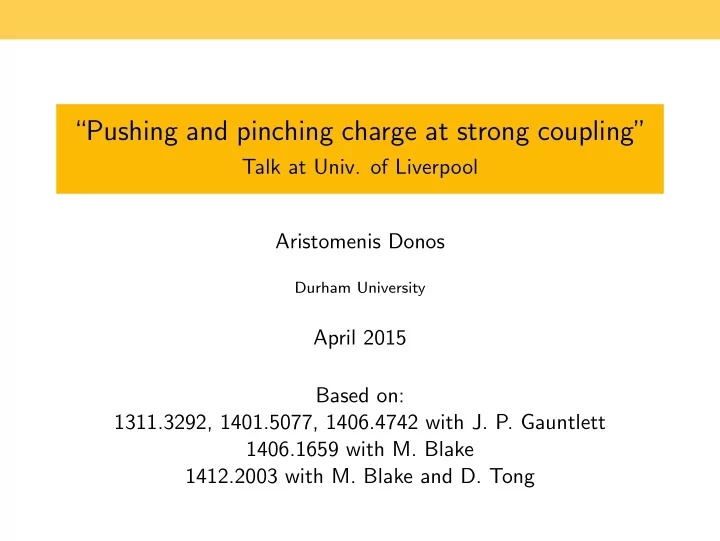

“Pushing and pinching charge at strong coupling” Talk at Univ. of Liverpool Aristomenis Donos Durham University April 2015 Based on: 1311.3292, 1401.5077, 1406.4742 with J. P. Gauntlett 1406.1659 with M. Blake 1412.2003 with M. Blake and D. Tong
Outline 1 Introduction/Motivation 2 The Holographic Lab 3 Holographic Charge Oscillations 4 Summary / Outlook
Outline 1 Introduction/Motivation 2 The Holographic Lab 3 Holographic Charge Oscillations 4 Summary / Outlook
Introduction/Motivation Some fun homework for the holographista: Part I Incoherent transport Anomalous scaling of Hall angle Part II Charge screening in holographic theories
Charge transport in real materials Drude peak σ Incoherent metal Mott insulator ω eV Materials with charged d.o.f. can be Coherent metals with a well defined Drude peak Insulators Incoherent conductors of electricity Interactions expected to become important in the incoherent phase → Possible description in AdS/CFT?
The Cuprates The Cuprates are real life example of : Incoherent transport Anomalous scaling of conductivity and Hall angle with T θ H ∝ T − 2 ρ DC ∝ T,
Anomalous Hall angle scaling Introducing a magnetic field B results in currents in two directions J x and J y . There is σ xx and σ yx Hall angle is θ H = σ xy /σ xx Fermi liquids + lattice Umklapp scattering lead to σ B =0 DC ∼ T − 2 , θ H ∼ T − 2 More generally, slow momentum relaxation predicts σ B =0 and DC θ H scale the same way with temperature [Hartnoll, Kovtun, Muller, Sachdev] Strange metals surprisingly have σ B =0 DC ∼ T − 1 , θ H ∼ T − 2 Holography evades that? Yes!
Outline 1 Introduction/Motivation 2 The Holographic Lab 3 Holographic Charge Oscillations 4 Summary / Outlook
AdS/CMT The recipe says: Field Theory Bulk Start with CFT d AdS d +1 Asymptotics Chemical potential µ U (1) electric charge Finite T Killing horizon 2-point function G JJ ( ω ) Bulk perturbation δA x , . . . Use Kubo’s formula σ ( ω ) = G JJ ( ω ) ıω
Perfect Holographic Conductor Do it in D = 4 Einstein-Maxwell with AdS asymptotics: L EM = R − 1 4 F µν F µν + 12 4 = − U ( r ) dt 2 + U ( r ) − 1 dr 2 + r 2 � ds 2 dx 2 1 + dx 2 � 2 A = a ( r ) dt Background black hole has temperature T , energy E , pressure P , entropy s and charge q .
Perfect Holographic Conductor To calculate conductivity need to source δA x = − e − ıωt E x ıω on the boundary Momentum ( δg tx ) couples because of background charge Infalling BC ( T s ) 2 q 2 ω << µ ⇒ σ = j/E x = ı E + P + ( E + P ) 2 ω [Hartnoll, Herzog] Conserved momentum → Infinite DC conductivity → Explicitly break translations on the boundary theory
Classical Drude model (Missing) Physics at ω << µ Average momentum obeys p � = qE − 1 τ � ˙ τ � p � ⇒ � p � 0 = qE 1 − ıωτ σ = nq 2 J = nq � p � τ m ⇒ J = σ E ⇒ m 1 − ıωτ Without collisions τ → ∞ ⇒ σ = nq 2 δ ( ω ) + ı � � m ω
Classical Drude model This is how it looks like 1.0 0.5 0.8 0.4 0.6 0.3 Re [ σ ] Im [ σ ] 0.4 0.2 0.2 0.1 0.0 0.0 0.00 0.05 0.10 0.15 0.20 0.00 0.05 0.10 0.15 0.20 ω ω
Fourier/Ohm law Apart from electric currents one also has a thermal current Q More generally, transport coefficients are packaged in a matrix � J � � � � � σ αT E = Q αT ¯ κT ¯ − ( ∇ T ) /T With ∇ T a temperature gradient
Holographic Lattice To add momentum dissipation introduce a UV - IR benign lattice: Keep UV fixed point ⇒ relevant deformation O ( x ) Drude physics ⇒ T = 0 horizon restores translations Charge density is a universal relevant operator ⇒ Impose A t = µ ( x ) − J t ( x ) r − 1 + · · · [Hartnoll, Hofman][Horowitz, Santos, Tong] µ ( x ) = µ 0 + A ( x ) , � A � L = 0 µ 0 ⇒ chemical potential, A ′ ( x ) ⇒ periodic electric field
Inhomogeneous Lattices The task is: 1) Solve elliptic non-linear PDEs to find background rippled black holes 2) Solve non-elliptic linear PDEs to find perturbations around numerical background to extract conductivity [Horowitz, Santos, Tong] [D&G] ⇒
Inhomogeneous Lattices The task is: 1) Solve elliptic non-linear PDEs to find background rippled black holes 2) Solve non-elliptic linear PDEs to find perturbations around numerical background to extract conductivity [Horowitz, Santos, Tong] [D&G]
Recommend
More recommend